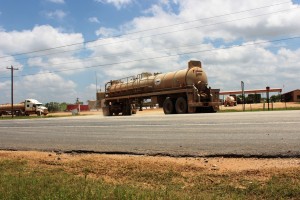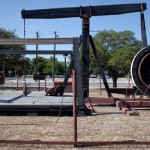Industry Looks for Safer Ways to Drill with Acid

Dave Fehling / StateImpact Texas
Trucks at a state-authorized disposal site in Frio County, Texas
Acids used for drilling oil and gas wells are safe according to the oil and gas industry, but companies have been looking for better alternatives to protect workers and the environment.
The concern over acids was highlighted this week in Pennsylvania, where there’s been a boom in drilling for natural gas. The state’s Department of Environmental Protection said it found that Halliburton Energy Services had for years failed to handle hydrochloric acid as a hazardous waste when it trucked it to an unauthorized disposal site. The state said the “acidic waste” had come from “various gas well sites.”
In an agreement with the state announced Tuesday, Halliburton agreed to pay a $1.8 million fine. The state said despite the violations, there was no harm done to people or the environment.
“Difficult to Handle Safely”
Hydrochloric and other acids are commonly used in drilling operations to dissolve rock as a well is drilled. Depending on how the acids are used, some processes are called acidizing when done at low pressure, while using acids at high pressure can be called acid fracturing.
The industry has said using acid is a decades-old technique that is “safe and well-understood.” Nonetheless, a review by StateImpact Texas of industry reports as well as interviews with industry experts show that for years there’s been interest in finding alternatives.
Reports and articles by industry researchers said hydrochloric acid was among acids that were “difficult to handle safely” and that the prospect of stricter government regulation, particularly in Europe, had increased the need for drilling chemicals that offered “reduced environmental and safety risks.”
There seemed to be a promising option, at least for some deeper wells with higher temperatures (wells at depths of 10,000 feet in some shale formations in South and East Texas can exceed 300 F). Mixtures involving less corrosive acids called chelants that worked in these hot wells were “much less toxic to mammal as well as to aquatic organisms.”
Safer but Expensive
But there was the matter of money: the alternative chemicals were “ten times as expensive,” according to one industry researcher. He didn’t want to be quoted by name, but told StateImpact Texas that some drilling services companies were “trying hard to find the most environmentally safe and cost effective” alternatives to the relatively cheap — but less safe — hydrochloric acid.
At the University of Texas, Tad Patzek, chairman of the Department of Petroleum Engineering, said that when it comes to using acids at drill sites, the biggest concern is worker safety.
“Human injuries, that would be the main danger of such a job,” Patzek told StateImpact Texas.
He downplayed environmental risks, at least when talking about what the acids might do after they’re injected into a well.
“These acids react immediately with the rock that surrounds them and are spent within minutes. So I think what the public needs to understand is whatever you do, that acid will be completely exhausted, used up by the minerals within the rock in minutes.” said Patzek. “So no, I don’t lose any sleep over acids working their way through the formation down there.”
